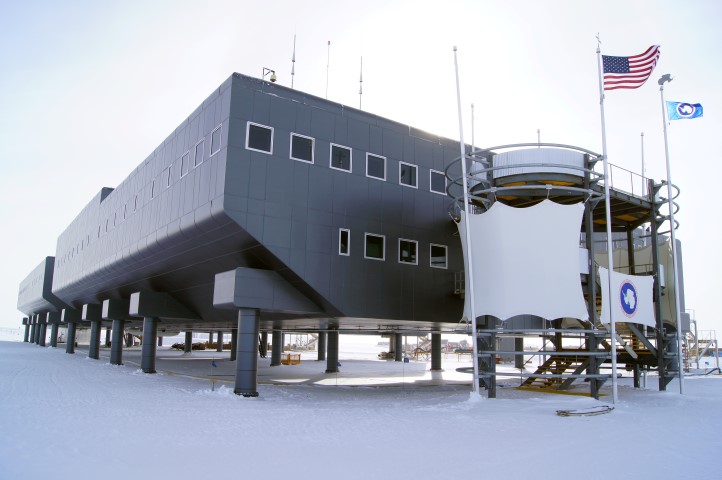|
Moving alongSouth Pole Station settles into operational mode five years after official dedicationPosted October 4, 2013
Elbow room. It’s not something one would think to be lacking at South Pole – a location so remote that the first polar explorers only visited the geographic bottom of the planet a little more than a century ago. A Norwegian team led by Roald Amundsen returned triumphant, while Robert Falcon Scott and his fellow Britons perished on the return trip. It took more than 40 years before anyone returned: A relatively small party of mostly U.S. Navy men and a handful of scientists established a research outpost in 1956, as part of the International Geophysical Year Photo Credit: Cliff Dickey/Antarctic Photo Library
The South Pole Station, also known as Old Pole, in 1957.
The Amundsen-Scott South Pole Station Designed to hold only 154 people, the station at times seemed more crowded than Seattle’s Pike Place Market at the height of tourist season. Big red parkas and tanned Carhartt jackets lined the long hallways. The cold weather gear belonged to the 100-plus Polies who lived in South Pole’s version of suburbia known as Summer Camp, a dozen or so tent buildings called Jamesways heated by furnaces. Meal times in the cafeteria nearly required traffic cops, as diners dashed in and out with trays of food laden with thousands of calories, as a bulwark against the extreme outdoor temperatures. In other words, there was no elbow room. Until this past season. Growing smallerThe station population dropped dramatically during the 2012-13 summer, a three-and-a-half month period when the sun shines 24 hours and ski-equipped military planes land with regularity on a packed snow skiway. The population never topped 168 people. “The big headline news this season is that we’re making that adjustment. We’re starting that trajectory toward design,” explained Bill Coughran, South Pole area manager, referring to the intention of operating the station based on its capacity to house everyone inside the 65,000-square-foot building. Photo Credit: Andrea Dixon/Antarctic Photo Library
South Pole Station Area manager Bill Coughran, left, visits with former French Prime Minister Michel Rocard during Rocard's visit to Amundsen-Scott South Pole Station in January 2011.
Gone is the 100-person strong construction crew that even in the summer worked in temperatures well below freezing to build the station and ancillary buildings like the power plant, garage and logistics arch. The cargo department has shrunk, now that the heavy stream of cargo planes bringing construction materials has turned into a trickle. “Ramping down in a program like this is hard. It’s difficult to get consensus on anything,” noted Coughran, who has spent more than 20 seasons on the Ice, including six winters. “We are ripping the Band-Aid off.” Even the big science projects of the last decade – the South Pole Telescope and IceCube Neutrino Observatory People appreciate the new elbow room, said Andres Martinez, South Pole Station facilities engineer. “The station is not bursting at the seams, the galley isn’t bursting at the seams, the lounges aren’t bursting at the seams with people,” said Martinez, who has twice wintered at the South Pole. “It’s actually very comfortable. They designed it right.” Inside, the layout includes a gymnasium, library, cafeteria, store, hydroponic greenhouse and single-person rooms with Internet connection. Outside, the aerodynamic design of the elevated station allows air to flow underneath the structure, which helps to control the snowdrift around the building. One problem with the two previous stations is that they were being buried and crushed by the weight of the snow. “The design of the building has done what it was supposed to do in terms of the scouring underneath,” Martinez said. “It’s drifting just like they said it would. It’s neat to see that.” |



For USAP Participants |
For The Public |
For Researchers and EducatorsContact UsU.S. National Science FoundationOffice of Polar Programs Geosciences Directorate 2415 Eisenhower Avenue, Suite W7100 Alexandria, VA 22314 Sign up for the NSF Office of Polar Programs newsletter and events. Feedback Form |


